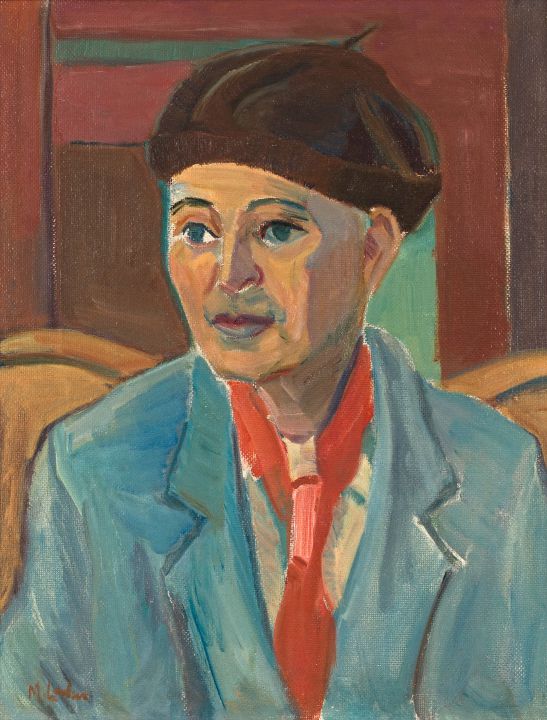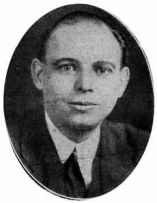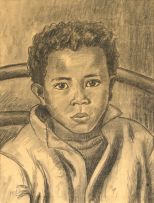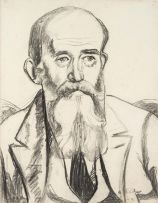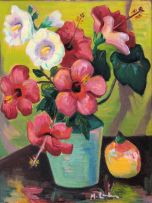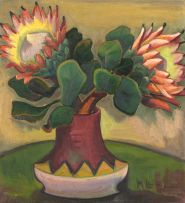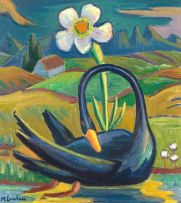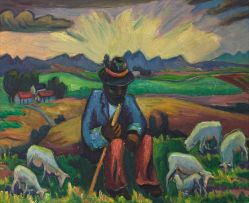Important South African & International Art, Decorative Arts & Jewellery
Live Auction, 6 March 2017
Important South African and International Art - Evening Sale
Incl. Buyer's Premium & VAT
About this Item
signed
Notes
Vere Bosman di Ravelli was the first South African to forge into Europe's musical world as a pianist. Previously known as Jan Gysbert Hugo Bosman, he adopted the pseudonym Di Ravelli in 1902 in Leipzig, when he began his career as a concert pianist. Being the youngest of three children, Bosman 'learned his notes' from his sister in Murraysburg and after school pursued his BA degree. In the year before his final examination he heard the spirited Chopin-playing of Apolline Niay in Cape Town and, by way of contrast, the physical virtuosity of Friedenthal. No other career but music became possible after these experiences.
On 1 October 1899 he set sail for Britain, and after a short stay in London moved to Leipzig where he became the pupil of Winterberger (professor of piano at the Conservatoire at Dufour). While pursuing his career as a pianist he gave lessons in English and the classical languages. One of his students, Hesse - conductor of a choir and chamber orchestra - was the first to appear on stage with Bosman in November 1902. In 1903 Bosman made his debut with Chopin's second piano concerto, supported by Hesse and his chamber orchestra. An extended tour through Germany launched his career which took him across Europe.
In September 1905 Bosman returned to South Africa. In the ensuing five years he gave a great many concerts in the Cape, the Free State and Transvaal without showing any profit. During the time he spent in South Africa he was the first to attempt the setting of Afrikaans poetry into music. He also founded a national academy of music. His skill, which was far advanced for his time, was unappreciated due to national and political unrest. Disappointed, he returned to Europe in November 1910 to resume his career as a pianist. There his career got into stride again only to be interrupted by the War in 1914. After the war he convalesced in Locarno in 1919, where he studied Arabic, supplementing his studies by delving into Hebrew, Chaldean, Samaritan, Syrian and later also Persian. A result of his studies was the completion of an Arabic - English glossary of the Quran.
Bosman resumed his career as a concert pianist in 1921 with Sharp's of England becoming his sole concert agents. During the approximately nine cold months of every year, he gave up to 80 concerts from Spain to Scandinavia. He used the summer months to prepare himself for the tours of the next year and to continue his oriental and classical studies.
The outbreak of World War ll meant the end of Bosman's European concert career. After the War, his house in Florence was only restored to him in 1952. Two years later he almost lost his arm in an accident, and in February 1956 he returned to South Africa and stayed with Maggie Laubser in Somerset Strand. In 1959 the South African Academy elected him as an honorary life member and in 1964 his fable titled 'St Theodore and the crocodile' was published.
Jacques Malan. (1979) The South African Music Encyclopedia, volume 1.
Exhibited
Johans Borman Fine Art, Cape Town, Persona, 11 October to 26 November 2011. Illustrated in colour on page 53 of the catalogue.
Literature
cf. Dalene Marais. (1994) Maggie Laubser: her paintings, drawings and graphics, Johannesburg and Cape Town: Perskor. A drawing of the same subject illustrated on page 321, catalogue number 1350.
